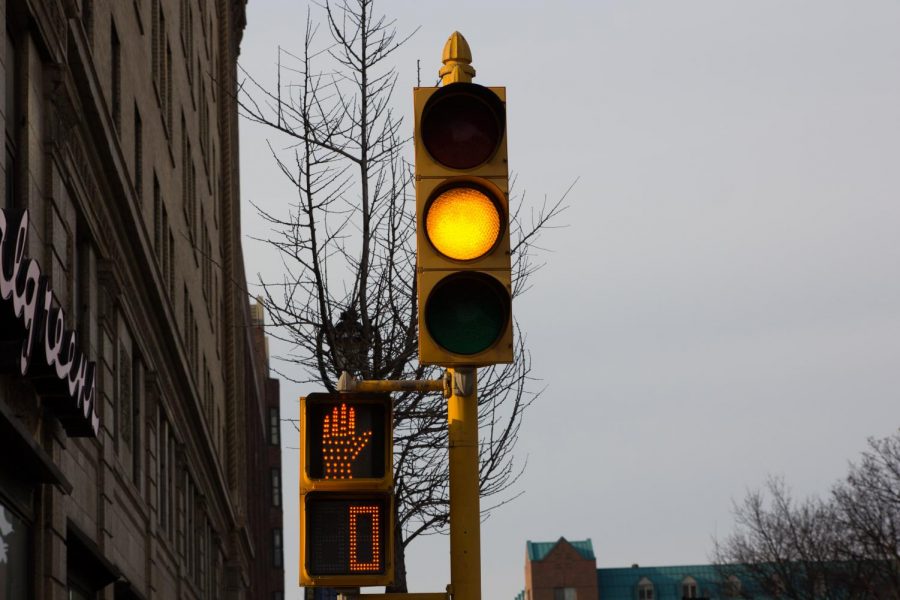Marquette University’s urban location paves way for speedy cars and traffic students walk past daily. Accidents on campus are becoming commonplace. A student was hit by a car while crossing the intersection of 17th and Wells streets last fall and a residence hall director sustained injuries after a driver slammed into her in the crosswalk in 2017. These events call for traffic regulation and change.
“A key part of the Jesuit tradition of higher education is that universities are located in urban centers, where faculty, staff and students live and work in the community,” Marquette University Police Department Chief Edith Hudson says in an email. “Our urban location is an asset in so many ways.”
The university vows that it works closely with the city of Milwaukee to keep the campus safe. University spokesperson, Lora Strigens, says all intersections and pedestrian crossings are evaluated with the campus community’s safety in mind.
However, some students say they have a different opinion.
“There’s cars speeding down Wisconsin Avenue and stories of people getting hit on campus (by cars),” Ellie McNeal, a junior in the College of Arts & Sciences, says. “If that doesn’t show the university that change needs to happen, I don’t know what will.”
In recent years the university has added flashing lights and pedestrian crossing signage on Wisconsin Avenue between 13th and 16th streets, and pedestrian crossing signage was added to a similar stretch of Wells Street, Strigens says.
The university has no imminent plans to add additional crosswalks or signage at this time, Strigens says. The development of the Campus Master Plan can be a start for future solutions.
The master plan is a comprehensive effort that explored all aspects of the physical campus, including transportation and circulation, Strigens explains.
The plan includes recommendations relative to pedestrian circulation, roadways and bike circulation, Strigens says. These changes will be considered as Master Plan projects
are implemented.
As projects come online, the university will work with the city to ensure that considerations relative to circulation are addressed, she says.
Students jaywalking can often be a part of the problem, McNeal says.
“Students are rushing to get to class and there are a lot of reckless drivers,” McNeal says. “It’s just not a
good combination.”
“It’s very important to follow the traffic laws,” Hudson says. “They’re there for a reason: to keep us safe.”
MUPD received an $8,000 grant from the Wisconsin Department of Transportation to increase pedestrian and traffic safety on campus back in 2015.
However, serious accidents, such as the student being hit by a vehicle on the intersection of 17th and Wells streets, occurred three years later in September 2018.
MUPD is currently looking at implementing pedestrian safety specialists that would be stationed at intersections and pedestrian crossings with the highest amounts of pedestrian and vehicular traffic, Hudson says.
”In discussion with students, faculty and staff, there was a recurring theme … that there had been improvements in pedestrian safety, but … there was still a little bit of concern,” Hudson says. Some of this concern is attributed to the speed of vehicles on campus.
The Pedestrian Safety Initiative comes following three major crashes on Marquette’s campus in the last two school years: two crashes into the Al McGuire Center and one crash into Johnston Hall.
“With the university’s full support, the Pedestrian Safety Initiative was developed to utilize student staffing in a way that makes the campus safer for pedestrians, with a focus on the busiest intersections,” university spokesperson Chris Stolarski says in an email.
Hudson says the final details are not yet finalized, MUPD will hire students at a rate she thinks is similar to the pay for Marquette LIMO drivers. MUPD will also reach out to other universities with similar programs, and details will be ironed out before the initiative’s implementation in fall 2019.
MUPD will potentially reach out to the Milwaukee Safety Division to help train students for the job, Hudson says.
“We want to make sure that whatever training we do provide is industry standard and something that would be consistent with training that (someone) would get anywhere,”
Hudson says.
Training student pedestrian specialists to draw drivers’ attention to pedestrians will be one part of the job.
“Student staff will be hired and trained in the coming months to serve as pedestrian safety specialists,” Stolarski says in an email. “When they start in the fall semester, they will be equipped with bright vests, whistles and hand stop signs to bring added attentiveness to pedestrians crossing those streets, as well as added visibility for passing motorists.”
Just as drivers must be aware of pedestrians, those walking must also take precautions to stay safe.
According to MUPDs website, important pedestrian safety tips include always walking on the sidewalk, not relying solely on pedestrian signals, removing headphones while crossing the street and making eye contact with drivers.
“Never assume that a vehicle is going to stop,” Hudson says. “Sometimes people just aren’t paying attention, it’s not like they’re intentionally trying to harm someone … (they just) may not see the pedestrian coming.”


